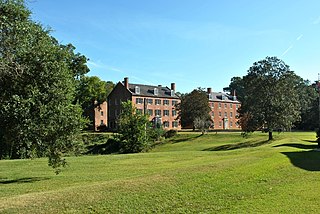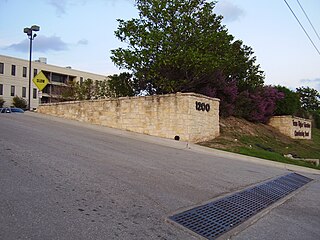
A corporal punishment or a physical punishment is a punishment which is intended to cause physical pain to a person. When it is inflicted on minors, especially in home and school settings, its methods may include spanking or paddling. When it is inflicted on adults, it may be inflicted on prisoners and slaves.
Education in the United States is provided in public and private schools and by individuals through homeschooling. State governments set overall educational standards, often mandate standardized tests for K–12 public school systems and supervise, usually through a board of regents, state colleges, and universities. The bulk of the $1.3 trillion in funding comes from state and local governments, with federal funding accounting for about $260 billion in 2021 compared to around $200 billion in past years.

Dunn is the largest city of Harnett County, North Carolina, United States. The population was 9,263 at the 2010 census, and an estimated 9,718 in 2018. It is the anchor city of the Dunn Micropolitan Area, population 114,678, which consists of Harnett County and is a part of the greater Raleigh–Durham–Cary Combined Statistical Area (CSA) as defined by the United States Census Bureau.

School discipline relates to actions taken by teachers or school organizations toward students when their behavior disrupts the ongoing educational activity or breaks a rule created by the school. Discipline can guide the children's behavior or set limits to help them learn to take better care of themselves, other people and the world around them.

Tape v. Hurley, 66 Cal. 473, (1885) was a landmark court case in the California Supreme Court in which the Court found the exclusion of a Chinese American student from public school based on her ancestry unlawful. The case effectively ruled that minority children were entitled to attend public school in California. After the Court's decision, San Francisco Superintendent of Schools, Andrew J. Moulder, urged the California state assembly to pass new state legislation which enabled the establishment of segregated schools under the separate but equal doctrine, like the contemporaneous Plessy v. Ferguson (1896). The establishment of the new school marked the continued segregation in the education system in California.

Jefferson College, in Washington, Mississippi, was founded as an all-male college but operated primarily as a college preparatory school and later military boarding school during most of its history. Named in honor of Thomas Jefferson, the college was chartered in 1802, but did not begin operation until 1811.
A spanking paddle is an implement used to strike a person on the buttocks. The act of spanking a person with a paddle is known as "paddling". A paddling may be for punishment, or as an initiation or hazing ritual.
Alexander City Schools is the public school district of Alexander City, Alabama, established in 1879. Alexander City Schools serves 2,948 students and employs 170 teachers and 67 staff as of the 2020-2021 school year. The district includes two elementary schools, two middle schools, and one high school.

Texas has over 1,000 public school districts—all but one of the school districts in Texas are independent, separate from any form of municipal or county government. School districts may cross city and county boundaries. Independent school districts have the power to tax their residents and to assert eminent domain over privately owned property. The Texas Education Agency (TEA) oversees these districts, providing supplemental funding, but its jurisdiction is limited mostly to intervening in poorly performing districts.
The South Delta School District (SDSD) is a public school district based in Rolling Fork, Mississippi, USA.

Covington County Schools is a public school district based in Covington County, Mississippi, which serves the towns of Collins, Seminary, and Mount Olive, as well as rural regions throughout the county. The district’s boundaries parallel that of Covington County.
The Florida education system consists of public and private schools in Florida, including the State University System of Florida (SUSF), the Florida College System (FCS), the Independent Colleges and Universities of Florida (ICUF) and other private institutions, and also secondary and primary schools as well as virtual schools.

Ingraham vs. Wright, 430 U.S. 651 (1977), was a United States Supreme Court case that upheld the disciplinary corporal punishment policy of Florida's public schools by a 5–4 vote. The judgment specified that such corporal punishments have no prohibition in public schools unless those punishments are “degrading or unduly severe”.

Leland Senior High School (LHS) is a public high school in Leland, Mississippi, United States. It educates approximately 336 students in grades nine through twelve. It is a part of the Leland School District. Leland Elementary and Leland School Park feed students into Leland High School.

Mississippi is a state in the Southeastern region of the United States, bordered to the north by Tennessee; to the east by Alabama; to the south by the Gulf of Mexico; to the southwest by Louisiana; and to the northwest by Arkansas. Mississippi's western boundary is largely defined by the Mississippi River. Mississippi is the 32nd largest by area and 35th-most populous of the 50 U.S. states and has the lowest per-capita income in the United States. Jackson is both the state's capital and largest city. Greater Jackson is the state's most populous metropolitan area, with a population of 591,978 in 2020.

School corporal punishment is the deliberate infliction of physical pain as a response to undesired behavior by students. The term corporal punishment derives from the Latin word for the "body", corpus. In schools it may involve striking the student on the buttocks or on the palms of their hands with an implement such as a rattan cane, wooden paddle, slipper, leather strap or wooden yardstick. Less commonly, it could also include spanking or smacking the student with the open hand, especially at the kindergarten, primary school, or other more junior levels.
Education in Alabama consists of public and private schools in Alabama, including the University of Alabama, private colleges, and secondary and primary schools.

The Davenport Community School District Is a public school district in Scott County, Iowa. The school district covers 109 square miles (280 km2) that includes the city of Davenport, where it is based, and the western Scott County communities of Blue Grass, Buffalo and Walcott in addition to a small section of Muscatine County. Founded in 1858 it established one of the first publicly funded high schools in the United States, the third teachers’ training school and hired the first female superintendent in the country. It serves nearly 16,000 students in 32 school buildings.

Gentry High School is a public secondary school in Indianola, Mississippi, part of Sunflower County. At 801 B.B. King Road, the school is part of the Sunflower County Consolidated School District and was formerly part of the Indianola School District.

Corporal punishment, sometimes referred to as "physical punishment" or "physical discipline", has been defined as the use of physical force, no matter how light, to cause deliberate bodily pain or discomfort in response to some undesired behavior. In schools in the United States, corporal punishment takes the form of a school teacher or administrator striking a student's buttocks with a wooden paddle.











